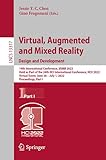Virtual, Augmented and Mixed Reality: Design and Development [electronic resource] : 14th International Conference, VAMR 2022, Held as Part of the 24th HCI International Conference, HCII 2022, Virtual Event, June 26 - July 1, 2022, Proceedings, Part I / edited by Jessie Y. C. Chen, Gino Fragomeni.
Contributor(s): Chen, Jessie Y. C [editor.] | Fragomeni, Gino [editor.]
| Fragomeni, Gino [editor.] | SpringerLink (Online service)
| SpringerLink (Online service) .
.
Material type:  BookSeries: Lecture Notes in Computer Science: 13317Publisher: Cham : Springer International Publishing : Imprint: Springer, 2022Edition: 1st ed. 2022.Description: XXV, 521 p. 202 illus., 170 illus. in color. online resource.Content type: text Media type: computer Carrier type: online resourceISBN: 9783031059391.Subject(s): User interfaces (Computer systems)
BookSeries: Lecture Notes in Computer Science: 13317Publisher: Cham : Springer International Publishing : Imprint: Springer, 2022Edition: 1st ed. 2022.Description: XXV, 521 p. 202 illus., 170 illus. in color. online resource.Content type: text Media type: computer Carrier type: online resourceISBN: 9783031059391.Subject(s): User interfaces (Computer systems)Developing VAMR Environments -- Integration of Augmented, Virtual and Mixed Reality with Building Information Modeling: A Systematic Literature Review -- Visualization of Macroscopic Structure of Ultra-High Performance Concrete Based on X-ray Computed Tomography using Immersive Environments -- Photographic Composition Guide for Photo Acquisition on Augmented Reality Glasses -- Method to Create a Metaverse using Smartphone Data -- Development of Standards for Production of Immersive 360 Motion Graphics, based on 360 Monoscopic Videos: Layers of Information and Development of Content -- Multi-user Multi-platform xR collaboration: System and evaluation -- Using Multi-Modal Machine Learning for User Behavior Prediction in Simulated Smart Home for Extended Reality -- Virtual Equipment System: Toward Bag of Holding and other Extradimensional Storage in Extended Reality -- Virtual Equipment System: First Evaluation of Egocentric Virtual Equipment for Sensory Settings -- Evaluating VAMR environments -- Effect of Personality Traits and Stressor Inducers on Users' Cognitive Load during Interactions with VR Environments -- The Development and Validation of an Augmented and Mixed Reality Usability Heuristic Checklist -- A Vibrotactile Reaction Time Task to Measure Cognitive Performance in Virtual and Real Environments -- Assessing User Experience of Text Readability with Eye Tracking in Virtual Reality -- Virtual Reality is Better Than Desktop for Training a Spatial Knowledge Task, But Not for Everyone -- Is Off-The-Shelf VR Software Ready for Medical Teaching? -- Ease of Use and Preferences across Virtual Reality Displays -- Objective Quantification of Circular Vection in Immersive Environments -- Are You There? A Study on Measuring Presence in Immersive Virtual Reality -- Gesture-based, haptic and multimodal interaction in VAMR -- Tabletop 3D Digital Map Interaction with Virtual Reality Handheld Controllers -- Hand Gesture Recognition for User Interaction in Augmented Reality (AR) Experience -- Natural 3D Object Manipulation for Interactive Laparoscopic Augmented Reality Registration -- Generating Hand Posture and Motion Dataset for Hand Pose Estimation in Egocentric View -- Real-Time Bimanual Interaction Across Virtual Workspaces -- Typing in Mid Air: Assessing One- and Two-Handed Text Input Methods of the Microsoft HoloLens 2 -- Learning Effect of Lay People in Gesture-Based Locomotion in Virtual Reality -- Flick Typing: A New XR Text Input System Based on Space Gestures -- Social, emotional, psychological and persuasive aspects inVAMR -- A Design Framework for Social Virtual Reality Experiences: Exploring Social and Cultural Dimensions for Meaningful and Impactful VR -- Designing Virtual Environments for Smoking Cessation: A Preliminary Investigation -- Social-Emotional Competence for the Greater Good: Exploring the Use of Serious Game, Virtual Reality and Artificial Intelligence to Elicit Prosocial Behaviors and Strengthen Cognitive Abilities of Youth, Adolescents and Educators - ASystematic Review -- Body-Related Attentional Bias in Anorexia Nervosa and Body Dissatisfaction in Females: An Eye-Tracking and Virtual Reality New Paradigm -- Enhancing Emotional Experience by Building Emotional Virtual Characters in VR Exhibition -- The Island of Play: Reflections on How to Design Multiuser VR to Promote Social Interaction -- Development of an Invisible Human Experience System using Diminished Reality -- Towards A Social VR-based Exergame for Elderly Users: An Exploratory Study of Acceptance, Experiences and Design Principles -- Relative Research on Psychological Character and Plot Design Preference for Audiences of VR Movies.
This two-volume set LNCS 13317 and 13318 constitutes the thoroughly refereed proceedings of the 14th International Conference on Virtual, Augmented and Mixed Reality, VAMR 2022, held virtually as part of the 24rd HCI International Conference, HCII 2022, in June/July 2022.The total of 1276 papers and 241 posters included in the 39 HCII 2021 proceedings volumes was carefully reviewed and selected from 5222 submissions. The 56 papers included in this 2-volume set were organized in topical sections as follows: Developing VAMR Environments; Evaluating VAMR environments; Gesture-based, haptic and multimodal interaction in VAMR; Social, emotional, psychological and persuasive aspects in VAMR; VAMR in learning, education and culture; VAMR in aviation; Industrial applications of VAMR. The first volume focuses on topics related to developing and evaluating VAMR environments, gesture-based, haptic and multimodal interaction in VAMR, as well as social, emotional, psychological and persuasive aspects in VAMR, while the second focusses on topics related to VAMR in learning, education and culture, VAMR in aviation, and industrial applications of VAMR.


There are no comments for this item.